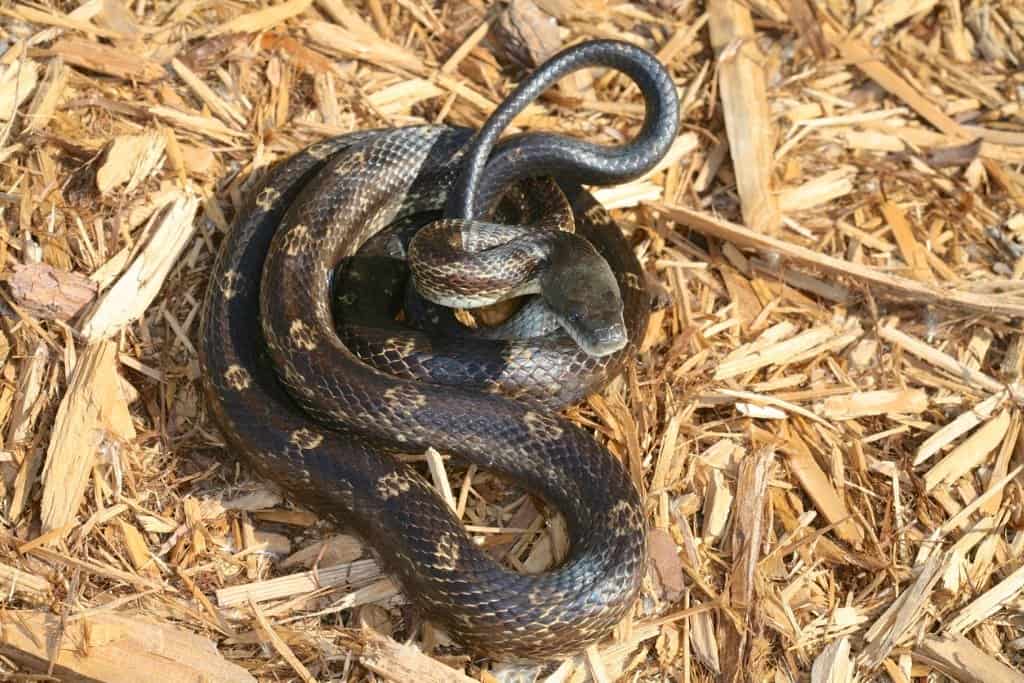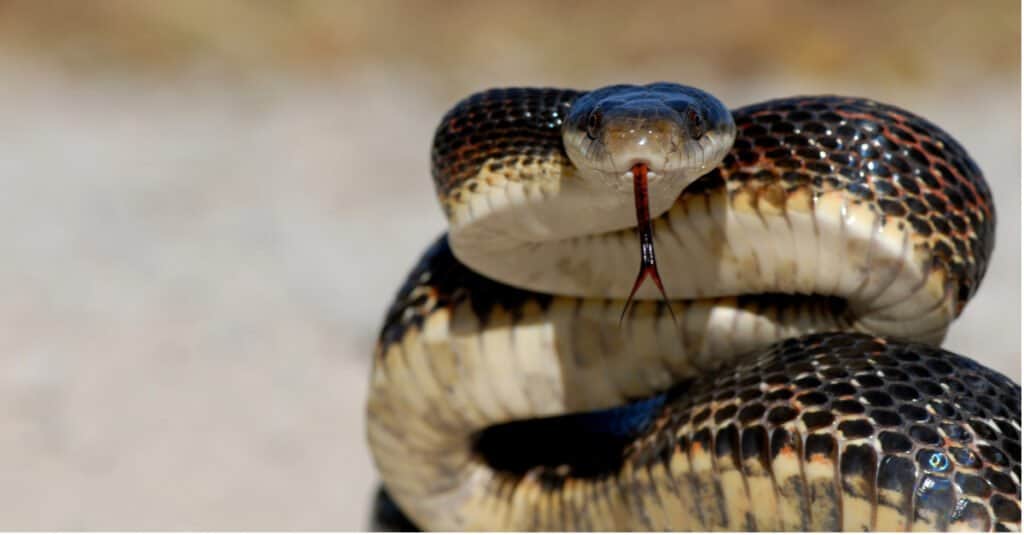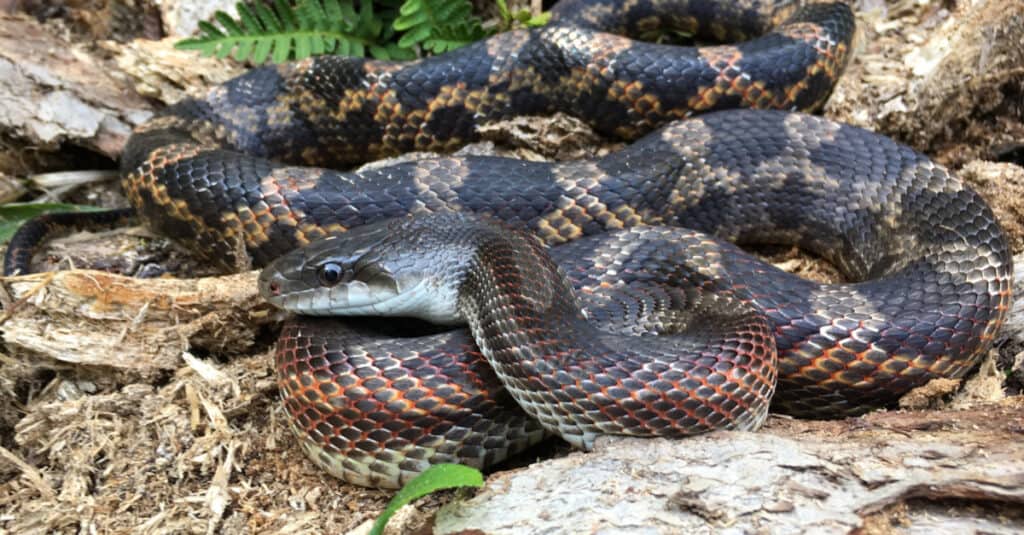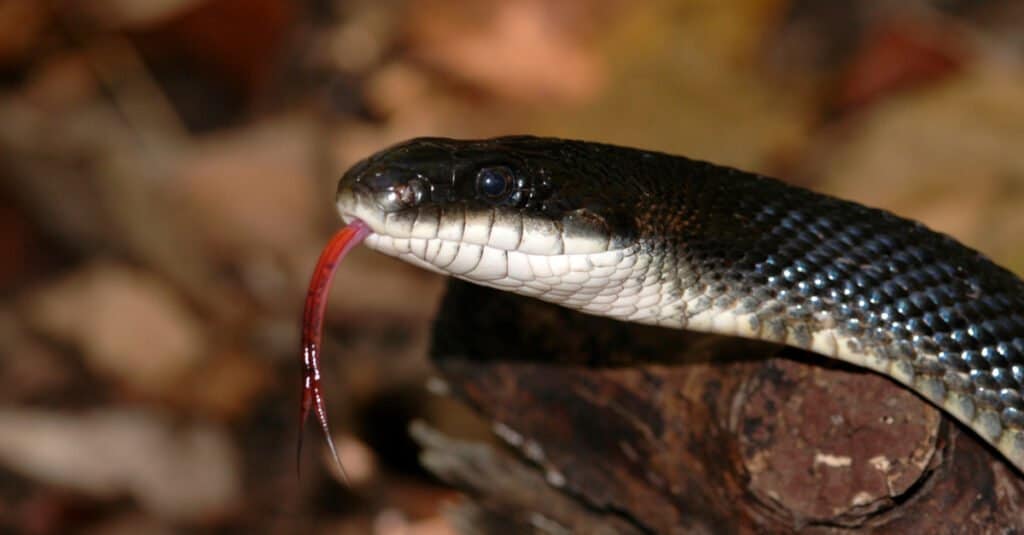Western Rat Snake
.jumbotron {
background-image: url(“https://a-z-animals.com/media/2022/02/pantherophis-obsoletus-western-ratsnake-shutterstock_1628055931-400×300.jpg”);
}
}
@media only screen and (min-width: 641px) and (max-width: 920px) {
.jumbotron {
background-image: url(“https://a-z-animals.com/media/2022/02/pantherophis-obsoletus-western-ratsnake-shutterstock_1628055931-470×370.jpg”);
}
}
@media only screen and (min-width: 921px) {
.jumbotron {
background-image: url(“https://a-z-animals.com/media/2022/02/pantherophis-obsoletus-western-ratsnake-shutterstock_1628055931.jpg”);
}
}
Western Rat Snake
P. obsoletus
Western rat snakes have special scales on their belly that help them climb up trees.
Western Rat Snake Scientific Classification
- Kingdom
- Animalia
- Phylum
- Chordata
- Class
- Reptilia
- Order
- Squamata
- Family
- Colubridae
- Genus
- Pantherophis
- Scientific Name
- P. obsoletus
Read our Complete Guide to Classification of Animals.
Western Rat Snake Conservation Status
Western Rat Snake Facts
- Prey
- Lizards, rats, mice, birds, squirrels, chipmunks
- Main Prey
- Rats, mice
- Name Of Young
- Hatchlings
- Group Behavior
-
- Solitary
- Fun Fact
- Western rat snakes have special scales on their belly that help them climb up trees.
- Most Distinctive Feature
- Adults have glossy black bodies that sometimes show faint patterns.
- Other Name(s)
- western rat snake, black rat snake, pilot black snake, black snake
- Temperament
- Docile
- Litter Size
- 6-20
- Habitat
- Rocky hillsides, farmland, abandoned buildings, forested areas
- Diet
- Carnivore
- Lifestyle
-
- Diurnal
- or Nocturnal Depending on Region and Season
This post may contain affiliate links to our partners like Chewy, Amazon, and others. Purchasing through these helps us further the A-Z Animals mission to educate about the world’s species..

Spiders that fly! Fish that walk! And 1000+ more incredible animals. Discover them all for FREE
.photo-gallery {
–margin: 0px auto 0px;
–padding: 0px 0px 0px 0px;
}
.gallery-link {
background-image: url(“https://a-z-animals.com/media/2022/02/pantherophis-obseletus-west-ratsnake-shutterstock_1043585599-1024×535.jpg”);
background-repeat: no-repeat;
background-size: cover;
background-position: center;
height: 500px;
justify-content: center;
text-align: center;
align-items: center;
display: flex;
border: 2px solid #000;
}
.gallery-link img {
height: 50%;
}
@media only screen and (max-width: 768px) {
.gallery-link {
height: 300px !important;
}
}
View all of the Western Rat Snake images!
Western rat snakes are one of the longest snakes in North America; the longest one on record measured 111 inches. They are long, slender, non-venomous constrictors that are terrific climbers. These snakes are members of the Colubridae family and are closely related to king snakes.
They’re a wonderful natural pest control that will seek out mice, rats, squirrels, birds, and even bats to eat. Juveniles often feed on lizards and frogs but as they mature develop a taste for rodents.
Amazing Facts About Western Rat Snakes
- The scales on their bellies flip up and grab onto surfaces which helps them climb to astounding heights.
- For such a large snake, they’re quite mellow. Once you’re holding one it calms down pretty quickly.
- Some people call them chicken snakes because they will get into a chicken coop and eat both eggs and chicks.
- They’re closely related to king snakes, and some pet breeders have bred hybrids of the two species.
Where to Find Western Rat Snakes
Western rat snakes are adaptable animals that will make a home wherever they find food. They prefer forested areas with a water supply, but happily take up residence in old barns, abandoned buildings, and under homes. These snakes are partly arboreal, and will sometimes lay their eggs high up in the hollow of a tree. They’re excellent climbers that you may find 20 feet up a tree that has no lower branches.
Their range extends west from the Mississippi River to central and northern Texas, and north to Iowa and Nebraska. Western rat snakes are long and slender, but powerful constrictors that suffocate their prey before swallowing it whole. These snakes sometimes reach 6 feet in length and darken as they mature; however, despite their size, they’re not aggressive at all.
They brumate beginning in October or November, finding a safe place to pass the colder months. as soon as the weather warms, western rat snakes become active again. Breeding takes place between April and June, the female lays her eggs in a secluded space about 4-6 weeks later. After 60-75 days the hatchlings emerge; these are excellent breeders, and females can lay up to 20 eggs at a time.
Western Rat Snake’s Scientific Name
This snake’s genus name, Pantherophis, means “Panther snake,” and it makes sense; the juveniles’ spotted pattern is reminiscent of panther, and as they develop their adult coloration the pattern is still somewhat visible on some individuals.
Types of Rat Snakes
With over 50 rat snake species occurring throughout the world, it’s often hard to keep track of them. Here are the species herpetologists know inhabit areas of the United States.
Bogertophis
Desert rat snakes occur in the Southwest United States into northern Mexico. There is a wide variety of habitats that Baja California rat snakes (B. rosaliae) and Trans-Pecos rat snakes (B. subocularis) inhabit.
Pantherophis
This genus holds most of the rat snake species in the United States. This includes the gray rat snake (P. spiloides), Eastern rat snake (P. alleghaniensis), Baird’s rat snake (P. bairdi), Great plains rat snake (P. emoryi), Eastern fox snake (P. gloydi), Western fox snake (P. ramspotti), Corn snake (P. guttatus), western (or black) rat snake (P. obsoletus), and Slowinski’s corn snake (P. slowinskii).
A few species in Pantherophis have subspecies; while others, such as the gray rat snake and western rat snake possibly hybridize near the Mississippi River. Genetically, many rat snakes are similar enough to also mate with king snakes, and a few pet breeders have done this to create new morphs.
Western Rat Snakes: Population and Conservation
There aren’t any estimates of population, however, biologists believe they have a stable population in most areas. The IUCN Redlist considers them “Least Concern.” Their main threats, after the mistaken identity issues and collection for the pet trade, are predation from other animals. Birds of prey (red-tailed hawks even hunt the larger snakes), coyotes, foxes, minks, and snakes all make being a western rat snake a dangerous occupation.
That said, in some states where they are less common, such as Minnesota, they’re listed as a species of special concern. They have only been documented in a couple of southeastern counties in the state; so in 2013, after many studies, the state of Minnesota classified it as a threatened species.
Identifying Western Rat Snakes: Appearance & Description
This is a fairly large snake, although it’s not very thick. Western rat snakes can reach 6 feet long, and the record was set by a wild-caught snake that measured over 8 feet (101 inches). Most snakes average from 4-6 feet. Young snakes have a bright, high-contrast pattern with a grey background and dark brown blotches on the back and sides. The blotches on their backs have slight points at the corners, and those on the sides are more irregular in shape. They darken rapidly as they mature, and many of these snakes become almost solid black on their backs but retain lighter colors with black spots on their bellies. Most of them have a white chin, but not all.
Western Rat Snakes Pictures and Videos

iStock.com/Naja Shots

Rusty Dodson/Shutterstock.com

Joe Farah/Shutterstock.com

Rusty Dodson/Shutterstock.com
How Dangerous are Western Rat Snakes
These snakes aren’t dangerous; however, if you corner one it may freeze and hope you don’t see it, bite, release an awful smelling musk, rattle its tail, or coil up and strike. Western rat snakes have several defenses against threats and will use any tool at their disposal to escape injury.
- At the first sign of a threat, a western rat snake may stiffen and kink up, giving its body a zig-zag shape; it may also freeze in place, hoping you won’t see it.
- If that fails, then it might coil up, form its neck into an ‘S’ shape, and rattle its tail. Some believe the tail rattle is mimicking rattlesnakes, but other disagree because the same behavior occurs in many snakes around the world where there are no rattlesnakes.
- At this point, if you are still bugging this snake, it will bite. Fortunately it won’t be too bad; remember, it doesn’t have any venom.
- Its last resort (not that biting isn’t bad enough), is to release musk from its vent, or cloaca. This stuff stinks. It doesn’t wash off well, and sort of sticks to you until you scrub a lot.
All that said, it’s not a dangerous snake, and is very helpful to people. They keep rodents (and other critters) from taking over the world.
Western Rat Snake Behavior and Humans
Western rat snakes aren’t aggressive, and they won’t come after you. Most often, these snakes try to escape. Even as they’re being harassed by someone they’re looking for an escape route. While human encroachment can be a problem for them, by and large, they have adapted to life in the suburbs.
However, many of these snakes are killed because of their pattern; people mistake them for rattlesnakes or copperheads and panic. In addition to confusing their pattern with venomous snakes, western rat snakes, like many other non-venomous snakes, can spread their head out to look more diamond-shaped like a pit viper; however, from above the snake’s head, its eyes are easy to see. A pit viper’s eyes are very difficult to see from above its head.
These constrictors perform a vital service, and while they are often found in some unexpected places, they’re harmless.
View all 74 animals that start with W
Western Rat Snake FAQs (Frequently Asked Questions)
Are western rat snakes venomous?
No, like all rat snakes, western rat snakes are non-venomous.
How do western rat snakes hunt?
These snakes are active diurnal and spend most of their day actively seeking a meal. They are constrictors, so when they bite their prey, they also wrap tightly around it to suffocate it before swallowing.
Where do western rat snakes live?
Western rat snakes inhabit forests and meadows in the central United States. It prefers heavily wooded areas but is adaptable.
Are western rat snakes aggressive?
They’re not aggressive, but they will defend themselves.
If you corner one, it puts on a display that includes rattling its tail to mimic a rattlesnake, coiling and forming its head and neck into an ‘S’ shape; finally, if you pick it up, it may bite and release musk, a foul-smelling substance it spreads around with its tail.
What do western rat snakes eat?
These are opportunistic feeders and will eat a wide variety of prey animals. Their favorites are warm-blooded prey, such as rats, mice, and birds.
What’s the difference between a black racer and black rat snake?
The main differences between a black racer and a black rat snake are their markings and sizes. Black rat snakes are larger than black racers, and black racers prefer to run away while black rat snakes hold their ground.
Sources
- Reptile Database, Available here: https://reptile-database.reptarium.cz/
- IUCN Redlist, Available here: https://www.iucnredlist.org/species/90069553/90069569
- Western Rat Snake | Seneca Park Zoo, Available here: https://senecaparkzoo.org/animal-pages/western-rat-snake/
- Western Ratsnake | Missouri Department of Conservation, Available here: https://mdc.mo.gov/discover-nature/field-guide/western-ratsnake
















